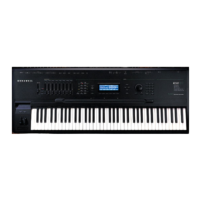Program Edit Mode
Arpeggiator Page
3-18
Shift Mode
Use the Shift Mode parameter to set how the arpeggiator will shift the pitch of played notes.
e Alg (algorithm) setting will let you create note sequences based upon a xed Shift
Amount. When you select Patt (pattern), the Shift Pattern parameter will appear, allowing
you to select a preset or user dened shift pattern. See Shift Pattern below for details.
Shift Limit
When the Shift Amount parameter is set to a value other than 0, Shift Limit determines how
far up or down the Arpeggiator can shift the arpeggiated notes. Try setting Shift Limit to 12
or 24 to create an arpeggio that repeats the same pattern of notes in dierent octaves. is
works well when Shift Amount is set to 12 or when a Shift Pattern is selected.
Shift Amount
When the Shift Mode is set to Alg, Shift Amount appears. Shift Amount determines how
much transposition will occur for each cycle of notes. Try setting Shift Amount to 12,
and Shift Limit to 12 or 24 to create an arpeggio that repeats the same pattern of notes in
dierent octaves.
Shift Pattern
When Shift Mode is set to Pattern, the Shift Pattern parameter appears, which allows you to
select a step sequence for arpeggiator note patterns. e note number of each played key is
shifted according to a sequenced pattern, thus “Shift Pattern.” ere are pre-programed shift
patterns including many useful chords, intervals, and rhythms. You can also create a custom
user pattern using the pattern editor (see below for details).
Shift Pattern steps are played back at the rate set for Beats. Keep in mind that Shift
Patterns are aected by every parameter on the Arpeggiator page, which can be the cause of
unexpected variation, or a way to add interesting variation to a pattern.
Shift Patterns are most easily used and understood when triggered by only one key at a
time. One way to prevent triggering from multiple keys is to use one of the Latch types
1NoteAuto, 1NoteAutoLow, or 1NoteAutoHi when using a shift pattern. Triggering shift
patterns from one key allows the pre-programed patterns to sound like what you would
expect from their names (otherwise the results can be unpredictable). If no other keys are
playing, patterns will start over each time a key is pressed (there are some exceptions to this
when using Arpeggiator Latch settings other than “Keys,” though a newly triggered pattern
will always start at step 1).

